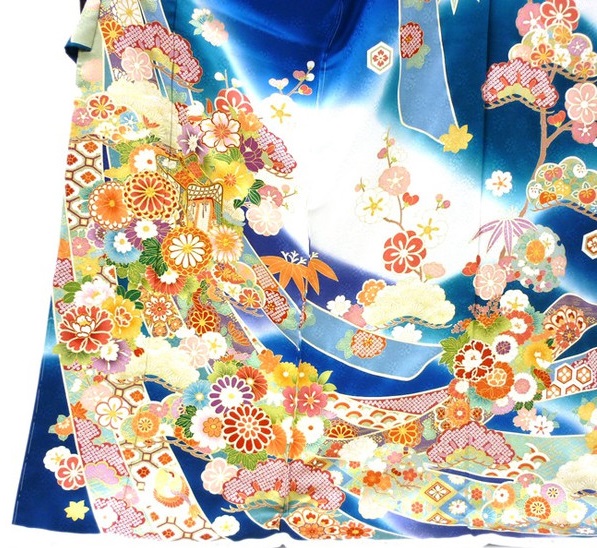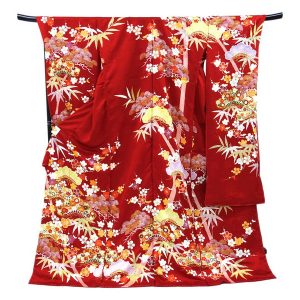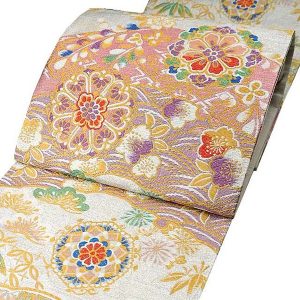If you were to be asked what’s Japan’s national dress the answer is undoubtedly Kimono. This garment is considered the national attire of Japanese society, and is worn in important occasions for the Japanese People, such as weddings, and it’s a very important part of cultural ceremonies like the traditional tea ceremony or Japanese dance; or artistic events such as kabuki theater or noh. It is also Kimono that’s used by important people in Japanese society such as Shinto priests, geishas and rakugo interpreters among others. Even though western style clothing and apparel took the place of Kimono as an every day garment, they still have great popularity among Japanese citizens and tourists, So they represent a truly desired item that many people would like to own.
Characteristics of Kimono
Kimono is created from a long piece of fabric that is about 36 cm x 12 m it is the cut into several sections that are then sewn together according to a pattern. It is a tradition hold dear by many people that in families the mother’s Kimono is inherited by the daughter when she comes of age. This Kimono is adapted to the daughters measures, and it’s cleaned and pressed to look good as new. Thus the same Kimono can pass from generation to generation maintaining its original beauty. Very similar to how wedding dresses are handed down from mother to daughter in western cultures.
Kimono History
Originally the word “Kimono” was used for all types of garments, they were worn everyday by people from all walks of life, the during the end of the military government of the Tokugawa (bakufu) in the 19th century ( the bakumatsu period) western clothes arrived among other Western objects. Then it became important to differentiate these clothes from Japanese garments ( wafuku). Up to this day Kimono is undoubtedly the maximum exponent of wafuku in general. Kimono is a living expression of Japan’s Art and history. Kimono comes a wide variety of designs, fabrics, embroidery, painted fabric and prices depending on the station of the person that’s supposed to wear it, so here we have 3 popular types of Kimono that you’ll want to know about.
3 Types of Kimono
Yuzen
This is a method of fabric dyeing for Japanese traditional Kimono robes. It’s name comes from it’s creator a painter from Kyoto named Miyazaki Yuzen Sai. Yuzen is distinctive because of the “itome-nori” process, which is a technique that consists of placing starch (nori) on the lines of the patterns so that the juxtaposing colors do not mix. The itome-nori allows use of multiple colors and fine and beautifully detailed patterns. Kimono with Yuzen design is truly breathtaking with its amazing hand painted look, they are truly a wonder you’ll want to own, and we have many different styles on our site you’ll want to check out.
Komon
Komon literally means “small print”. This term a somewhat wide term that applies to any Kimono with a print covering the entire surface of the Kimono, also with no particular direction or layout. The actual design can be any kind of pattern, the key of its design is that it’s repeated in the entire garment. Usually the patterns are smaller the older the person wearing them is, and also the more formal the occasion for wearing Kimono is. They can be used in a number of events and are truly Japanese items that will make you Happy you own them.
Nishijin
Nishijin is a beautifully intricate technique that was created in Kyoto over 1200 years ago, it is different from others because is a kind of weaving, so it uses many different types of colored yarns, weaving them together into decorative designs. This technique employs some very tedious and specialized procedures that are absolutely necessary to obtain the truly spectacular designs of the Nishijin weaving. Truly spectacular, and some times pricey, this is the kind of item to be passed down generation to generation. So go ahead, get one and start a tradition.
After Word

Kimono is widely popular because they are a tangible representation of Japanese culture. Truth is Kimono is high on the list of things tourists want to buy during their visit to the country. And they are worth it because wearing Kimono is something that is worth experiencing at least once in a lifetime. Get yours, purchase one in our site now!















